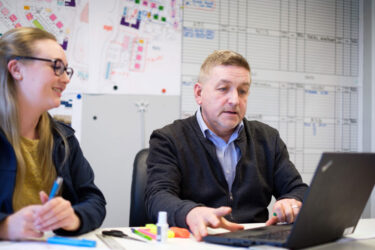Taking the leap to work on the client-side


One year in, she explains why she has no regrets.

As any architect will appreciate, having worked through seven long, challenging years of architectural education, it was no easy decision to take a job at a contractor.
One view that architects probably all share, regardless of the contractor that they are working with, is a growing sense of frustration that they are becoming removed from the actual building of buildings. The advent of design and build has slowly helped to erode the influence architects have over quality, cost and programme the golden triangle of any project.
This is drummed into us as part III students. We understand the delicate balancing act of the tenuous triptych but, in practice, have little input in maintaining this equilibrium, and often are not privy to the information we’d require anyway. The role of the architect has become too insular and focused on design.
I have often heard throughout my career that architects are great designers, have fantastic imaginations, great drive and can create quality spaces, but are bad businessmen. Somehow, along our journey to becoming creators of beautiful buildings, we have been pigeonholed into ‘design’ only and, in doing so, have lost the ability to make a greater impact, to hold more influence and integrate the things we value.
It was not a decision I took lightly to move from a private practice to the contractor side but, having now worked for Wates Residential as a Design Manager for over a year, it’s not a decision I regret.
The biggest challenge for me was the move from a medium sized practice where nearly everyone was an architect to a company of approximately 4,000 people with diverse roles and skills. Fortunately, I am site based and the small team within my office means that I am now part of an immediate team of 30 making the transition into a larger company much easier. However, moving away from the close knit architectural based studio and team structure is something I miss I have always felt that the sense of camaraderie within architecture is what makes the long hours and stresses of the job bearable, as you work towards a single goal.
Working contractor side, each member of the team straddles various projects with different roles, skills and priorities. Fortunately, my experience working with different consultants as an architect has helped me to walk the tightrope between planners, clients, residents and every other person involved in the design process.
The relationships are very much the same, treading between what the client wants, what they can afford and what we can realistically deliver. My role is to help guide the client through the process, manage expectations and achieve the best outcome in the time and budget available. But now, sitting on contractor side, I have a better understanding and control over quality, cost and programme I am sitting on the inside, no longer an architectural consultant on the outside. So often changes are imposed on architects as projects are navigated through each stage of the process, leaving a feeling of powerlessness. Working contractor side, there is a much greater sense of control.
I have realised too that architects have more skills and experience than they probably recognise and knowledge that others on the construction side often do not have – which can be easily transferred to, and benefit, other parts of the process. By sitting on the contractor side, the Design Manager has a unique role in straddling between the realities of building and the aspirations of the architect. While having the best interests of the contractor at the forefront, the Design Manager also has an appreciation and understanding of the architectural approach. It is this appreciation that makes for good teamwork, ensuring both sides work together towards the best outcome achieving balance within the golden triangle.
It is also a great feeling to actually get to build stuff which is what architects first dreamt about when enrolling at architecture school. Considering sequencing, co-ordination, detailing it’s the ‘doing’ part of being an architect. Being on site, talking to sub-contractors, sitting in a freezing cold site hut working out a waterproofing detailyou get the feeling that you are part of the building process. The Design Manager also has to understand the role of MEP and structure, and have a much more rounded view of the project than the modern day design and build architect, which, whilst a new challenge, has been fun to get to grips with.
Of course, it’s not the panacea for architects frustrated with the construction process – and I won’t lie, the early morning starts have been an adjustment but my decision to work on the contractor side has restored a sense of creativity within me and an enjoyment in being able to shape of the built environment I haven’t felt in a long time.